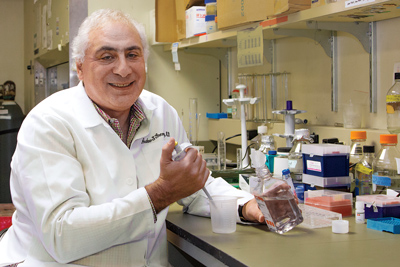By Ben Goldfarb ’09
A researcher’s latest discovery could be a crucial development in figuring out how to help people modulate their food intake.
[Health] Obesity is among the most pervasive epidemics in the United States—and also among the most complex. Scientists are only now beginning to understand the interplay of nutrition, exercise and
genetics that makes more than a third of Americans obese. Few researchers are doing as much to crack the mystery as Andrew Greenberg ’77, director of the Obesity and Metabolism Laboratory at the Tufts Human Nutrition Research Center on Aging.
Greenberg’s research focus was driven by personal tragedy. His mother, Beatrice, suffered from obesity-related diabetes, an illness that eventually took her life. Greenberg was working as an endocrinologist at the National Institutes of Health when his mother had a stroke. “The reality is we have more food than we need and we exercise less than we should,” he says. “And a lot of us are predisposed to developing obesity and associated diseases such as diabetes—which, as I personally witnessed, can be devastating.”

Obese people, Greenberg soon discovered, produce less perilipin in their fat cells than those who are not obese. Without perilipin to coat the lipid droplets, the fats within those droplets escape into the bloodstream, in the form of fatty acids. There, the fatty acids circulate to muscles and other organs, instigating the insulin resistance that leads to Type 2 diabetes. “A lot of what I do involves solving puzzles—and by solving puzzles, we can identify possible therapies,” Greenberg says.
Perilipin is a crucial piece in the obesity puzzle. Its discovery has helped researchers understand how certain antidiabetic drugs, such as a class of medications called thiazolidinediones, work: these drugs increase the body’s production of perilipin.
Greenberg and colleagues recently discovered that another form of perilipin, called perilipin 2, may have the opposite effect: by removing the gene that produces perilipin 2, they were able to breed mice that ate less and gained less weight when presented with a high-calorie diet. This latest discovery, says Greenberg, could be a crucial development in figuring out how to help people modulate their food intake.
Greenberg’s lipid research continues to spiral in surprising new directions. Among his current projects, he’s exploring how the intestine, and the microbes that dwell in it, affect metabolism: “It turns out the intestine secretes hormones and signals to the brain. If you could affect that pathway, you could tell the brain to feel satiated.”
Ben Goldfarb ’09 is a freelance science writer.
Deb Dutcher photo
New Grads in the Lab

As a mentor, Greenberg says, it’s most crucial to instill in young scientists an appreciation for the painstaking pace and rigor of the scientific process. “You don’t make a discovery every day,” he says. “It requires persistence and thoughtfulness.”
For information on how to hire a student through Amherst Advantage, the Career Center’s recruiting program, email oncampusrecruiting@amherst.edu.